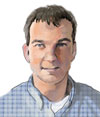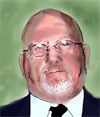January 20, 2008

On Gaia's Good Side
One hopes that most devout Christians — Catholics especially — have a wave of initial suspicion upon hearing such admonitions as "if we only care about heaven, then we've lost Jesus' sense of urgency about loving your neighbor. We're all kin, so my neighbor is also the polar bear and the bumblebee." It is wise, in such company as was to be found at the Rhode Island Interfaith Power and Light conference at Bishop Hendricken, last week, to resist the urge to run to one's Bible for contrary evidence. But...
I've thus far missed the passage wherein the disciples ask Jesus when they helped Him and He replies, "I was a polar bear, and you preserved my natural habitat." And I seem to recall His offering a statement about the comparative value of sparrows and people.
Oh, I'm fully persuaded that good stewardship of the natural world is among mankind's responsibilities, but embracing such bromides as "greening your congregation" and such fashionable solutions as those cute (mercury-containing) compact fluorescent bulbs feels a bit more like an answer to the call of Gaia, than of Yahweh:
The eco-conversion [keynote speaker and Episcopal priest Margaret Bullitt-Jonas] described, and encourages others to undergo, had three steps closely modeled on Christian theology.First is "Creation" — developing an awareness of and appreciation for God's creation. Then, "Crucifixion" — feeling grief and guilt for the things humans have done to creation. Ultimately, "Resurrection" — working for justice, healing and reconciliation. She encouraged those in the audience to take stock of the things that they do to harm the planet and the things they can do to help it. Even doing something small, she said, will make you "wake up in the morning and have a little more integrity." She commended those who attended for taking at least the first step in this journey. "We together are the future we need to be seeing more of."
Justice for the planet? The dodo as the recrucified Lord? Recycling as a measure of human integrity? Just compare the confusing contrivedness of that last quotation with the awe inspiring concision of the very name of God.
There's something related, in the religious quarters of the greening movement, to the topic of Fr. John Kiley's latest Quiet Corner column in the print edition of the Rhode Island Catholic:
The heightened appreciation of the sacred element in church life by younger priests and seminarians (as well as by some older priests) might be a justified reaction to the social worker mentality that many priests adopted in the 1960s, '70s and '80s. Priests, and religious, became agents of change rather than ministers of the Gospel. A role proper to the laity was assumed by the clergy. The transformation of the secular world became the preoccupation of many priests, while loss of faith in the supernatural grew apace among both clergy and laity. ...This assimilation of mainstream Catholic America into (let's be honest) mainstream Protestant America seems to call precisely for a renewed appreciation of everything that is uniquely Catholic: the parish priest as the embodiment of mediatorship within the Catholic community; the Eucharist as Christ's sacrifice renewed by the priest at the altar; the assurance of forgiveness offered through the priest's formal absolution; the word of authentic revelation and tradition preached daily from Catholic pulpits; the witness of celibacy as a firm affirmation of fulfillment in the next life; and, precisely as indicated by Pope Benedict in his recent encyclical on hope, a keen spiritual focus on heaven, eternity and the world-to-come.
We are called to look toward the Kingdom of God, which is not of this world. If the warmth of an incandescent bulb or, more to the point, the monetary and psychic resources not devoted to reduced carbon footprints can do more to lead us thereto than "eliminating disposable dishes," I say that we allow our churches to keep the hue that they naturally attain, whether by incense or energy-inefficient stained glass.



 About Community Crier
About Community Crier

 About Engaged Citizen
About Engaged Citizen




